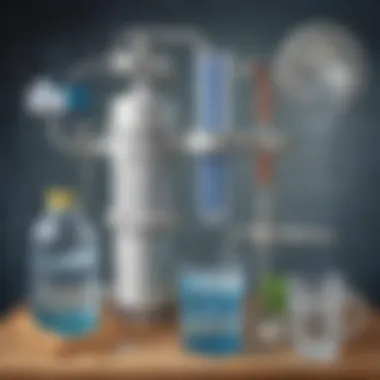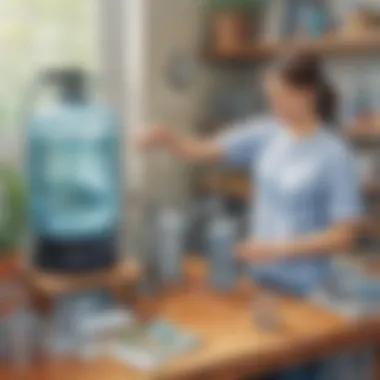Easy DIY Water Filter Guide without Charcoal: Step-by-Step Instructions


Science Fun Facts
Water filtration has been an essential process throughout history, ensuring access to clean and safe drinking water. Did you know that ancient civilizations used natural materials like sand and gravel to filter water? This method laid the foundation for modern filtration techniques.
Discover the Wonders of Science
By understanding the principles of filtration, we can appreciate the importance of purifying water. The process of filtration involves separating impurities from water, creating a healthier and safer drinking source. Through this DIY project, we delve into the scientific concepts behind filtration and its practical applications in our daily lives.
Science Experiment Showcase
Embark on a journey to construct your own water filter without charcoal using simple household items. This hands-on experiment allows us to explore the effectiveness of various filtration layers in removing contaminants. From understanding the role of each material to following safety precautions, this project provides a unique opportunity to learn and apply scientific principles in a practical setting.
Introduction
Water filtration is a fundamental process in ensuring the safety and quality of the water we consume. In this detailed guide, we will explore how to create a homemade water filter without the use of charcoal. By engaging in this DIY filtration method, individuals can take control of their water purification process using easily accessible materials found in most households.
Purpose of Water Filtration
Importance of Clean Water
Clean water is essential for maintaining good health and preventing water-borne diseases. The significance of clean water cannot be overstated, as it directly impacts our well-being and daily functioning. Through the filtration process, harmful impurities and contaminants are removed, ensuring that the water we drink is safe and pure. This DIY filtration method emphasizes the value of clean water and empowers individuals to safeguard their health through proactive water purification.


Need for DIY Water Filtering
The need for DIY water filtering arises from various factors, including limited access to commercial water filtration systems, a desire for self-sufficiency, and an interest in sustainability. DIY water filtering offers a cost-effective and efficient solution for individuals seeking to purify their water without relying on external sources. By engaging in DIY filtration, individuals can customize their filtration system according to their specific needs and preferences, making the process more personalized and accessible.
Materials Needed
In the process of creating a water filter at home without charcoal, several essential materials play a crucial role. These items are integral to the effectiveness and efficiency of the filtration system. Understanding the significance of each material ensures the successful purification of water through this DIY method.
List of Required Items
- Plastic Bottle: The plastic bottle serves as the primary container for the filtration system. Its convenience lies in its availability and ease of modification. Plastic bottles are lightweight, durable, and can be easily pierced or cut to create openings. They are a popular choice for DIY water filters due to their accessibility and versatility.
- Sand and Gravel: Sand and gravel act as the filtration media, capturing debris and impurities as water passes through them. Their coarse texture effectively traps particles, enhancing the overall filtration process. The interplay between sand and gravel aids in separating larger sediment from the water, contributing to cleaner and clearer outcomes.
- Coffee Filter or Cloth: A coffee filter or cloth acts as a secondary filtration layer to further refine the water. These materials help sift out finer particles that may have bypassed the initial sand and gravel layers. Their porous nature enables them to sieve even tiny contaminants, improving the quality of the filtered water.
- Activated Charcoal (Optional): Although optional, activated charcoal serves as an additional purification agent in DIY water filters. Its porous structure is highly effective in adsorbing pollutants and unpleasant odors, enhancing the taste and smell of the filtered water. Activated charcoal can be a valuable inclusion for those seeking extra purification.
Preparation Steps
In the realm of crafting a water filter at home without charcoal, the Preparation Steps play a paramount role. It sets the foundation for the effectiveness and efficiency of the filtration system, ensuring that the process runs smoothly and the desired outcome is achieved. These steps are crucial in transforming ordinary household items into a robust purification mechanism. Understanding and following each preparation step meticulously is vital to the success and functionality of the homemade water filter.
Preparing the Bottle
When it comes to preparing the bottle for the water filter, the first step involves cutting the bottle to create the necessary structure for the filtration process. Cutting the bottle is a critical aspect as it dictates the size and shape of the filter. This step is instrumental in ensuring that the filter fits snugly into the container, allowing the water to pass through the filtration layers effectively. By carefully cutting the bottle, you pave the way for a streamlined filtering process, optimizing the purification of the water.
Creating holes in the bottle serves a specific purpose in enhancing the filtration efficiency. These holes facilitate the flow of water through the filter layers, enabling thorough purification. The strategic placement of holes is key to maintaining a balanced flow rate, preventing clogs, and ensuring consistent filtration. This step in the preparation process is essential for promoting optimal water purification and increasing the overall effectiveness of the homemade filter.
Assembling the Filter Layers


Adding gravel to the filter contributes significantly to the overall filtration process. The gravel layer serves as the initial barrier, catching larger impurities and sediment present in the water. This step is essential for improving the quality of the filtered water, removing visible contaminants and enhancing the purification efficiency. By incorporating gravel into the filter layers, you establish a solid foundation for capturing and eliminating debris, ensuring cleaner water output.
Layering sand atop the gravel layer further refines the purification process. The sand acts as a finer filter, trapping smaller particles and sediment that may have bypassed the gravel layer. This additional filtration step enhances the water quality by removing finer impurities, sediment, and debris, resulting in clearer and purer filtered water. Layering sand is a critical component in achieving high-quality water purification through the homemade filter.
Placing a filter, such as a coffee filter or cloth, at the uppermost layer of the filtration system is the final step in assembling the filter layers. This layer acts as the last line of defense, capturing any remaining particles and impurities to ensure the water is thoroughly purified before consumption. The filter layer plays a crucial role in refining the water quality, providing a final polish to the filtration process. By carefully placing the filter, you create a comprehensive purification system that delivers clean and safe drinking water.
Filtering Process
In the realm of homemade water filtration, the 'Filtering Process' stands as a pivotal stage, delineating the efficacy and efficiency of the entire filtration mechanism. The process boasts significant importance as it embodies the core essence of purifying water through DIY methods without the utilization of charcoal. By meticulously passing water through the filter layers, contaminants and impurities get trapped, ensuring a cleaner and safer drinking water source for domestic use. The intrinsic value of the Filtering Process lies in its ability to transform a basic plastic bottle and simple materials into a functional filtration system, catering to the fundamental need of access to clean water within everyday households.
Pouring Water through the Filter
Observing Filtration
Delving deeper into the intricate workings of water filtration, 'Observing Filtration' manifests as a crucial component in the filtration journey. This process entails keenly watching as water traverses through the makeshift filter layers, assessing how effectively impurities are sieved out. The very essence of Observing Filtration lies in its ability to provide a visual confirmation of the filtration process in action, showcasing the tangible impact of the DIY water filter. This observational element not only adds a practical dimension to the filtration process but also aids in gauging the filter's efficiency and identifying any potential areas of improvement. The interactive nature of Observing Filtration engages DIY enthusiasts in the water purification process, fostering a sense of involvement and mindfulness towards water quality enhancement.
Testing the Purity
When navigating the terrain of homemade water filtration, 'Testing the Purity' emerges as a critical step that underpins the overarching goal of obtaining clean and potable water. This facet entails subjecting the filtered water to rigorous purity checks, ensuring that contaminants have been adequately removed through the DIY filtration setup. Testing the Purity encapsulates a meticulous evaluation process that validates the efficacy of the homemade water filter, certifying its ability to deliver safe drinking water. By analyzing the water sample post-filtration, individuals can ascertain the success of the filtration process and make informed decisions regarding the consumption of the purified water. The meticulous nature of Testing the Purity not only affirms the utility of the DIY filtration method but also instills confidence in the makeshift system, highlighting its capacity to meet the desired purity standards.
Maintenance and Reusability
In the realm of DIY water filtration, understanding the critical aspect of Maintenance and Reusability is paramount. Ensuring the longevity and effectiveness of your homemade water filter hinges on proper upkeep and the ability to reuse it efficiently. Maintenance not only guarantees the purity of the filtered water but also extends the life cycle of the filter, making it a cost-effective and sustainable choice. Reusability, on the other hand, emphasizes the eco-friendly nature of homemade filters, reducing waste and promoting environmental conservation.


When delving into the Maintenance and Reusability of your DIY water filter, it is crucial to consider factors such as regular cleaning routines and timely replacements. By adhering to a maintenance schedule that includes rinsing the filter layers and replacing any worn-out components, you can ensure optimal performance and address any potential contamination issues effectively. This proactive approach not only safeguards your health but also enhances the efficiency of your filtration system, providing clean and safe drinking water.
Cleaning the Filter
Rinsing the Layers
As you embark on the cleaning process of your homemade water filter, focusing on rinsing the layers plays a pivotal role in maintaining its functionality. Rinsing the layers involves delicately washing away accumulated debris and impurities that may hinder the filtration process. This step is essential in preserving the porosity of the filter materials, ensuring unobstructed water flow and maximum purification.
The key characteristic of rinsing the layers lies in its simplicity yet profound impact on the filter's performance. By clearing any blockages or contaminants trapped within the layers, you guarantee consistent water quality output. The unique feature of rinsing is its ability to refresh the filter media, revitalizing its efficacy without the need for extensive replacements. This cost-effective and pragmatic approach to maintenance underscores its significance in the context of DIY filtration.
Replacing the Filter
When focusing on the aspect of replacing the filter, the emphasis shifts to the filter's lifespan and efficiency over time. Replacing the filter is a crucial element in ensuring continued water purity and unrestricted flow. The key characteristic of this process is its role in maintaining the integrity of the filtration system, preventing degraded filter components from compromising water quality.
The unique feature of replacing the filter lies in its ability to rejuvenate the entire filtering mechanism, eliminating any potential risks associated with prolonged use. While it necessitates periodic replacement of filter elements, this practice is fundamental to sustaining optimal filtration performance. The advantages of regular filter replacements include consistent water quality, extended filter longevity, and minimized chances of bacterial growth, aligning with the essence of a reliable DIY water filter system.
Conclusion
When it comes to the topic of a homemade water filter without charcoal, the significance cannot be overstated. The DIY filtration method offers a practical solution for individuals seeking to purify water using readily available resources within the household. By following the step-by-step instructions provided in this guide, anyone can create a cost-effective and efficient purification system without the need for charcoal, making clean water accessible to a broader demographic.
Efficacy of Homemade Water Filters
Benefits of DIY Filtration
Exploring the benefits of DIY filtration unveils a compelling aspect of this method. One key characteristic is the simplicity and accessibility it offers. Unlike complicated commercial water filters, DIY filtration allows individuals to create a functional system using basic items like plastic bottles, sand, gravel, and a coffee filter. This simplicity makes DIY filtration a popular choice, especially for those looking for an affordable and sustainable water purification option. Another advantage lies in the customization potential of homemade filters, enabling users to adjust the filtering layers according to their specific needs and water quality. While DIY filtration excels in cost-effectiveness and simplicity, it also encourages experimentation and personalization, setting it apart as a flexible and user-friendly water purification method.
Environmental Impact
Examining the environmental impact of homemade water filters sheds light on another crucial aspect of this topic. The key characteristic here is the eco-friendliness of DIY filtration. By utilizing everyday items to create water filters, individuals contribute to reducing plastic waste and promoting sustainability. Unlike commercial filters that often come with plastic casings and disposable cartridges, homemade filters emphasize reuse and recycling, aligning with eco-conscious practices. This unique feature not only reduces environmental footprint but also raises awareness about the importance of eco-friendly alternatives in water purification. While DIY filtration may have limitations in terms of scale and filtration capacity compared to industrial options, its minimal environmental impact makes it a compelling choice for environmentally conscious individuals.







